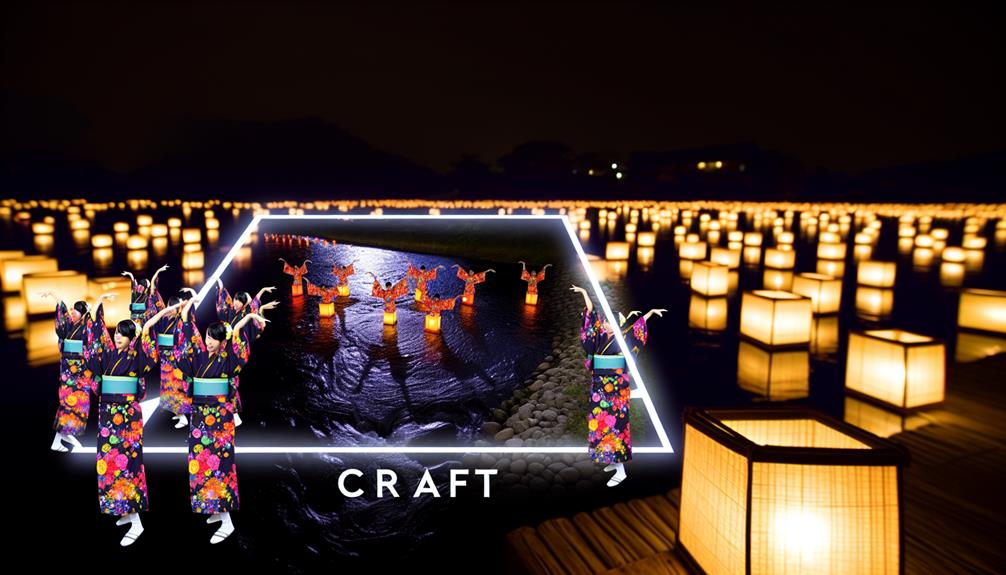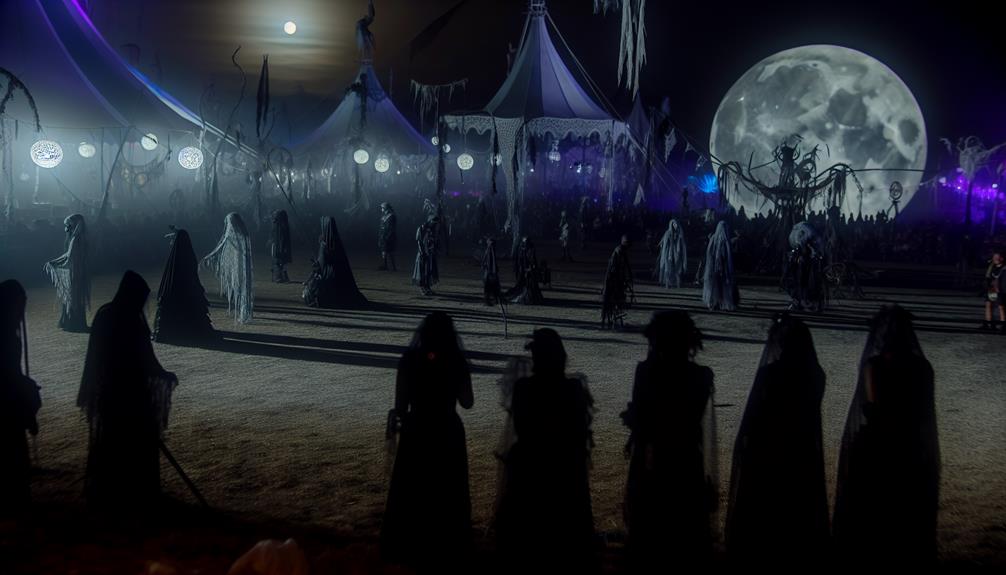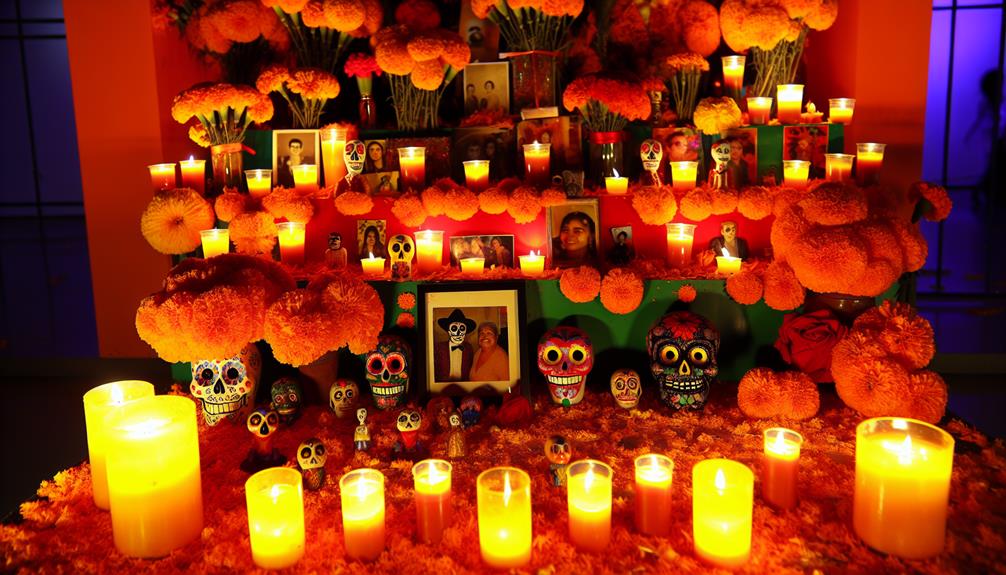The Obon Festival in Japan offers a fascinating glimpse into the country's vibrant cultural tapestry, blending ancient customs with modern-day celebrations. This annual event, steeped in Buddhist beliefs, transcends generations, serving as a poignant reminder of the importance of honoring one's heritage and ancestors. As families reunite and communities come together to pay respects and partake in age-old traditions, the festival becomes a gateway to understanding Japan's profound respect for the interconnectedness of past, present, and future. The allure of Obon lies not just in its rituals but in the deeper meanings that resonate throughout this time-honored festival.
Key Takeaways
- Obon Festival rooted in ancient Buddhist traditions, honoring ancestors' spirits.
- Traditional customs include attire, music, and offerings symbolizing respect.
- Festive dances with regional variations reflect cultural heritage and unity.
- Lanterns guide spirits, symbolize hope, and foster community unity.
- Culinary delights integral to Obon, showcasing Japanese food culture and heritage.
Origins of Obon Festival
The origins of the Obon Festival in Japan can be traced back to ancient Buddhist traditions and practices. This annual event, deeply rooted in Japanese traditions, holds great cultural significance for the people of Japan. The festival is based on the Buddhist custom of honoring the spirits of one's ancestors. It is believed that during Obon, the spirits of the deceased return to the earthly world to visit their living relatives.
The cultural significance of the Obon Festival lies in its role as a time for families to come together to pay their respects to their ancestors. It is a period of reflection and gratitude, where offerings are made at altars and gravesites to honor and remember the departed. The festival also includes traditional dances, known as Bon Odori, where communities gather to dance in unison to traditional music.
In Japan, Obon is a time for both solemn remembrance and joyous celebration. It is a time to express gratitude for the sacrifices and contributions of past generations, while also enjoying the company of family and friends. The festival serves as a reminder of the interconnectedness of past, present, and future, highlighting the importance of honoring one's roots and heritage.
Traditional Obon Customs
Rooted deeply in Japanese culture, Traditional Obon Customs encompass a rich tapestry of rituals and practices that have been passed down through generations. During the Obon Festival, individuals often wear specific attire and engage in traditional dances accompanied by unique music.
Traditional Obon Customs:
| Obon Attire | Obon Music |
|---|---|
| Traditional clothing such as yukatas or kimonos are commonly worn during Obon. These garments symbolize respect for ancestors and are often colorful and elegant. | Obon music plays an essential role in the festival, setting the tone for various ceremonies and activities. The melodies are usually rhythmic and soothing, creating a serene atmosphere for honoring the deceased. |
The Obon attire reflects the cultural significance of the festival by showcasing respect and reverence for ancestors. The intricate designs and vibrant colors of yukatas and kimonos add to the visual spectacle of the event. On the other hand, Obon music serves as a means of connecting with the spirits of the departed. The harmonious tunes evoke a sense of nostalgia and contemplation, allowing participants to reflect on the memories of their loved ones.
In essence, Traditional Obon Customs provide a glimpse into Japan's rich heritage and spiritual beliefs, emphasizing the importance of honoring ancestors through symbolic clothing and melodic expressions.
Festive Obon Dances
Incorporating graceful movements and symbolic gestures, Festive Obon Dances are a mesmerizing showcase of cultural heritage and spiritual reverence during the traditional Japanese Obon Festival. The dance styles performed during Obon vary across regions, with some areas showcasing slow and elegant movements while others feature lively and energetic routines. These dances are accompanied by traditional music played on instruments like drums, flutes, and shamisen, creating a captivating auditory experience that complements the visual spectacle.
Participants in Festive Obon Dances often wear vibrant and elaborate festive attire, including yukatas and kimonos adorned with intricate patterns and designs. Accessories such as colorful fans, umbrellas, and sashes are commonly used to enhance the beauty and grace of the dancers as they move in synchronized harmony. The combination of the dynamic dance movements, traditional music, and ornate costumes creates an enchanting atmosphere that transports both performers and spectators to a world where tradition and spirituality converge.
Comparatively, Festive Obon Dances reflect the rich tapestry of Japanese culture, blending elements of history, religion, and artistry into a harmonious expression of community unity and respect for ancestors. Through these dances, participants pay homage to their heritage while celebrating the enduring traditions that have been passed down through generations, making Festive Obon Dances a cherished and integral part of the Obon Festival experience.
Meaning of Obon Lanterns
Symbolizing illumination and remembrance, Obon lanterns play a significant role in the traditional Japanese festival. These lanterns are not just decorative elements but hold deep cultural significance, representing various beliefs and traditions associated with the Obon Festival. Here are five key aspects that illuminate the meaning of Obon lanterns:
- Guiding Ancestors: Obon lanterns are believed to guide the spirits of ancestors back to the world of the living during the festival. The soft glow of the lanterns acts as a beacon for the returning spirits, helping them find their way.
- Symbol of Hope: The warm light emitted by the lanterns symbolizes hope and positivity. It signifies the belief that ancestors are watching over their descendants, offering protection and blessings.
- Honoring the Departed: By lighting lanterns, families pay homage to their deceased loved ones. It is a way to show respect and remember those who have passed away, keeping their memories alive.
- Community Unity: The tradition of hanging lanterns in front of houses fosters a sense of community unity. It brings people together to celebrate and honor the spirits of the departed ancestors collectively.
- Cycle of Life and Death: The presence of lanterns underscores the cyclical nature of life and death in Japanese culture. It serves as a reminder of the interconnectedness between the past, present, and future generations.
In essence, Obon lanterns serve as more than just decorative items; they embody the spiritual essence and cultural richness of the Obon Festival in Japan.
Culinary Delights at Obon
An integral component of the Obon Festival in Japan, the culinary delights served during this festive occasion offer a tantalizing glimpse into the rich tapestry of Japanese food culture. Obon is a time for families to come together, honor their ancestors, and enjoy traditional dishes that have been passed down through generations. This celebration is not only a feast for the soul but also a feast for the taste buds, showcasing a wide array of food traditions and local specialties.
To truly explore the essence of Obon, one must investigate the culinary landscape that defines this festival. From savory street foods to delicate sweets, Obon offers a diverse range of dishes that cater to every palate. Below is a table highlighting some of the food traditions and local specialties commonly enjoyed during Obon:
| Food Category | Description | Local Specialty |
|---|---|---|
| Street Foods | Yakisoba – Stir-fried noodles with veggies and meat | Takoyaki – Octopus-filled savory balls |
| Sweets | Mochi – Glutinous rice cakes | Taiyaki – Fish-shaped pastries |
| Beverages | Green tea – Traditional Japanese tea | Ramune – Carbonated soft drink |
These culinary delights not only nourish the body but also serve as a way to connect with Japanese heritage and create lasting memories with loved ones during the Obon Festival.
Frequently Asked Questions
Are There Any Specific Colors or Designs for Traditional Obon Attire?
When considering traditional obon attire, the colors and designs hold significant cultural importance. The attire reflects historical influences, with specific colors and patterns often symbolizing various aspects of the festival's significance.
Over time, there have been trends in modifying traditional attire, incorporating modern elements while still honoring the festival's roots. Understanding the intricate details of traditional obon attire can provide insight into the rich cultural heritage and evolving fashion trends within this celebration.
What Are Some Modern Adaptations or Variations of Obon Dances?
Innovative choreography and fusion music adaptations characterize modern variations of traditional dances. Dancers infuse creativity, breaking barriers with unique movements and blending diverse musical genres.
These adaptations bring a fresh perspective, appealing to a wider audience and breathing new life into age-old traditions. By exploring new forms of expression, modern obon dances evolve to captivate spectators and participants alike, showcasing a dynamic fusion of tradition and innovation.
Do Different Regions in Japan Celebrate Obon in Unique Ways?
Regional traditions during festivals showcase diverse cultural variations, enriching the tapestry of celebrations. Different regions in Japan honor events like Obon uniquely, reflecting historical influences, local beliefs, and geographical distinctions.
These variations contribute to the vibrancy and richness of cultural practices, fostering a deeper understanding of the interconnectedness between traditions and communities. Embracing these unique expressions of heritage highlights the beauty and diversity of Japan's regional celebrations.
Are There Any Superstitions or Taboos Associated With Obon Lanterns?
Taboo beliefs and superstitions surrounding lantern decorations are prevalent in various cultures worldwide.
The symbolism and placement of lanterns during festivals or celebrations often carry significant meanings that must be honored.
In some societies, using certain colors or designs on lanterns may be considered bad luck or disrespectful to tradition.
Understanding these taboos is essential to respecting the cultural significance of these illuminated decorations.
Can You Find Vegetarian or Vegan Options at Obon Food Stalls?
When exploring food stalls at festivals like Obon, visitors with dietary preferences for vegetarian or vegan options can find a range of choices to suit their needs.
These options often include plant-based dishes that are creatively prepared to offer a flavorful and satisfying experience.
Conclusion
To sum up, the Obon Festival in Japan serves as a sacred time for families to honor their ancestors through traditional customs, dances, lantern lighting, and culinary delights.
This cultural event symbolizes unity, respect, and remembrance, highlighting the rich heritage and values of the Japanese community.
It offers a unique opportunity for reflection, making offerings, and celebrating the cycle of life and death in a festive and meaningful way.


